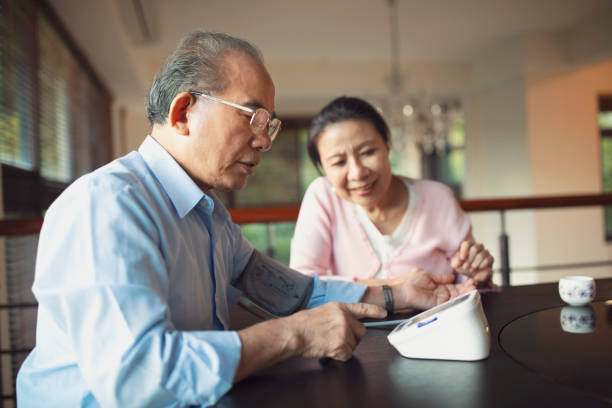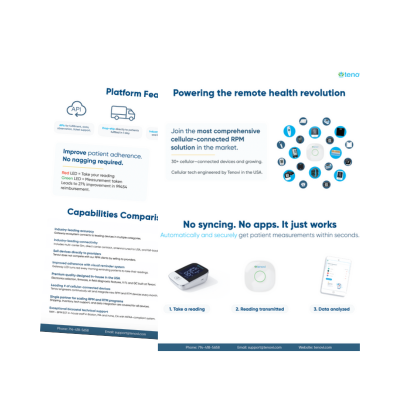Remote patient monitoring (RPM) devices in healthcare give care teams the ability to manage chronic diseases, post-acute recovery, and high-risk patients at home. Instead of relying on self-reported logs, RPM devices give healthcare teams real-time access to vital sign data, enabling faster interventions, reduced hospitalizations, and more personalized care.
In this guide, we’ll explore how RPM devices work, the conditions they support, and a breakdown of the seven most widely used RPM devices in healthcare today. By the end, you’ll have a clear understanding of which devices matter most for your patient population and how to implement them effectively in clinical practice.
Cellular-Connected Remote Patient Monitoring Devices
Tenovi remote patient monitoring devices use Bluetooth to connect to the Tenovi Cellular Gateway. A cellular gateway offers versatility. With the Gateway, multiple Bluetooth medical devices connect and transmit health data through cellular networks. The data from all devices is aggregated into the Tenovi cloud and then to any remote patient monitoring platform through one simple API.
Tenovi also partners with leading device manufacturers such as A&D Medical, Omron, Transtek, and Trividia Health, Adherium, PatchRx, Welch Allyn and Nonin to offer a variety of Bluetooth and cellular devices including blood pressure monitors, blood glucose meters, pulse oximeters, peak flow meters, a smart pillbox, watch, thermometer and weight scales. The Gateway technology enables seamless integration of many devices for remote data collection and transmission. Ultimately, this gives health systems, RPM software, and service companies flexibility in meeting their providers’ diverse needs.
7 Common Remote Patient Monitoring Devices in Healthcare
Once a measurement is taken, remote patient monitoring devices automatically transmit patient readings to RPM portals for care providers to access in real-time. Each RPM device measures a different vital sign. Depending on the patient’s condition, some devices are more ideal than others.
For example, someone who is pre-hypertensive will benefit from using a blood pressure monitor, while someone with diabetes will benefit from using a blood glucose meter. It is important to note that the sophistication and availability of these devices vary based on the remote monitoring service provider.
Several top remote patient monitoring devices are available to healthcare organizations, including:
- Blood pressure monitors
- Scales
- Bariatric Scales
- Glucometers
- Peak Flow Meters
- Pulse Oximeters
- Thermometers
In the following sections, we’ll review what conditions top remote patient monitoring devices help manage and how to use them.
1. Remote Patient Monitoring Blood Pressure Monitors
RPM Blood pressure monitors are remote patient monitoring devices that help individuals with hypertension ensure their blood pressure stays within a healthy range. Hypertension is a major risk factor for many chronic care diseases like heart failure, chronic kidney disease, and stroke. It is also concerning during pregnancy.
Fortunately, with remote blood pressure monitoring, clinicians can identify complications early and provide prompt treatment by tracking patients’ blood pressure between visits. The blood pressure monitor will display systolic blood pressure, diastolic blood pressure, and heart rate.
The top number is the systolic blood pressure measurement. This indicates the pressure in the arteries when your heart beats. According to the American Heart Association, any reading above 130 mmHg is considered hypertensive. The second number is the diastolic blood pressure measurement, the amount of pressure between heartbeats. Any reading above 80 mmHg is considered hypertensive.
How to Use a Blood Pressure Monitor
Most top RPM digital blood pressure monitor devices are user-friendly, making them ideal for remote use. Tenovi’s BPM works right out of the box, eliminating the hassle of device setup.
For the best results, encourage your patients to:
- Relax for about 5 minutes before
- Sit comfortably and avoid crossing your legs
- Keep their arm resting on top of a table or armrest
- Empty their bladder
- Measure around the same time every day
- Avoid eating, exercising, caffeine, and alcohol for at least half an hour before
- Take the measurement twice, about a minute apart, to ensure accuracy, and then average the numbers
To use a blood pressure monitor, wrap the cuff around the upper arm (ensure the cuff is on bare skin, not clothing) and press the middle button. The cuff will inflate, measure blood pressure, and automatically send the data to the RPM platform.
2. Remote Patient Monitoring Scales
A weight gain of 3 or more pounds in a single day can indicate congestive heart failure. Congestive heart failure occurs when the heart cannot efficiently pump blood throughout the body. At-risk individuals typically experience shortness of breath, tightness in the chest, and dizziness. While it is entirely normal for weight to fluctuate, weight gain in at-risk patients can serve as a precursor to more serious conditions. By monitoring a patient’s heart health with body weight, clinicians can quickly identify signs of heart failure and focus on early management.
How to Use a Weight Scale
With both a cellular-enabled scale and cellular-connected scale, all the patient has to do is step on the scale to turn it on and wait for the reading. The information will automatically be sent to the clinician, and the RPM device will turn off independently.
For the most accurate results, advise patients to:
- Weigh themselves at the same time every day (preferably in the morning)
- Avoid eating or drinking right before the weigh-in
- Wear the same clothing for each weigh-in, or weigh without clothes on
Regular bodyweight measurements can help healthcare providers evaluate the effectiveness of a patient’s management plan and, if necessary, quickly make adjustments to better control fluid retention.
3. Remote Patient Monitoring Bariatric Scales
Bariatric scales are a critical RPM device for patients requiring specialized weight management due to obesity, heart conditions, or related health issues. These scales accommodate individuals with higher body weight, providing accurate and reliable measurements for chronic conditions, pre- and post-bariatric surgery care, and other weight-sensitive treatments.
For bariatric patients, weight fluctuations can indicate serious health concerns such as fluid retention, complications from surgery, or progression of chronic diseases like congestive heart failure. By remotely monitoring weight trends, healthcare providers can intervene early. Bariatric RPM scales also promote patient accountability and adherence to treatment regimens by providing real-time feedback on weight management progress.
How to Use a Bariatric Scale
A bariatric scale is simple to use, even for patients unfamiliar with technology. The Vitafit Bariatric Scale features a high-capacity platform and durable design, ensuring comfort and safety during use. The device integrates seamlessly with Tenovi’s Cellular Gateway for automatic and secure data transmission to clinicians.
- Patients will want to weigh themselves at the same time daily, ideally in the morning before eating or drinking.
- Recommend wearing consistent, light clothing or weighing without clothing for accuracy.
- Patients only need to step on the scale to activate it. The scale will automatically record the measurement and transmit it to the clinician portal.
- Regular monitoring helps patients and clinicians identify patterns, adjust care plans, and celebrate milestones in weight management.
4. Remote Patient Monitoring Blood Glucose Meters
Diabetes is the 8th leading cause of death in the United States. If poorly managed, diabetes can cause kidney failure, heart attack, stroke, and blindness. By utilizing either a cellular-connected or cellular-enabled glucometer to monitor blood sugar levels remotely, clinicians can better assess whether a patient’s treatment management plan is working and make adjustments to optimize care.
How to Use a Blood Glucose Meter
Tenovi’s Blood Glucose Meter is a top-line FDA-cleared remote patient monitoring device. It includes a cell-enabled meter, lancet, and custom test strips that simplify measuring blood sugar.
Gather all the materials and perform the following steps with clean hands:
- Insert the test strip into the meter
- Wipe your finger with an alcohol pad and let it dry
- Gently prick the side of the finger with the lancet
- Place a drop of blood onto the test strip and wait for the reading
Most patients should aim for blood glucose levels between 80-130mg/dL before a meal or below 180 mg/dL in about 2 hours after a meal. If patients’ blood glucose levels are too high, they may need to adjust their diet or medications.
5. Remote Patient Monitoring Peak Flow Monitors
How to Use A Peak Flow Meter
To begin using the Tenovi peak flow meter, relax for a few minutes before closely following these 3 easy steps.
- Turn it on. Press the power button for 3 seconds and wait for the Gateway to start flashing yellow.
- Take a reading: Take a deep breath, then exhale quickly into the peak flow meter.
- Data transfer: PEF and FEV1 data will automatically transfer to the Tenovi cloud or clinician portal.
PEF and FEV1 data will automatically transfer to the Tenovi cloud or clinician portal.
6. Remote Patient Monitoring Pulse Oximeters
Among the other remote patient monitoring devices in healthcare is a pulse oximeter. This device is useful for assessing lung disease is a pulse oximeter. A pulse oximeter measures heart rate and oxygen saturation in a patient’s red blood cells. Patients with conditions that affect blood oxygen levels, like heart attack, heart failure, COPD, anemia, lung cancer, asthma, and pneumonia, may benefit from regular pulse oximetry.
How to Use a Pulse Oximeter
Pulse oximetry is typically tested at the fingertips to measure how well oxygen is being sent to areas of your body furthest from the heart. This RPM is simple to use.
To use the Tenovi Pulse Oximeter, all the patient has to do is:
- Turn on the device. Place a finger inside the slit, and wait for the reading. A pulse oximeter uses light to measure the oxygen in your blood at a given point.
- Pulse oximeters will show blood oxygen saturation (SpO2) and pulse rate.
- Patients should seek medical attention if their reading indicates:
-
- SpO2 under 90% (hypoxia)
- Low pulse rate
- High pulse rate
Most top remote patient monitoring platforms will notify the healthcare provider immediately.
7. Remote Patient Monitoring Digital Thermometers
A remote patient monitoring thermometer is used for body temperature monitoring for early infection detection, where timely treatment is crucial. This is especially true in the case of sepsis. RPM digital thermometers are remote patient monitoring devices used in cancer care to monitor COVID-19 and postoperative patients. Regular temperature monitoring reveals symptom patterns and serves as a warning signal when abnormalities arise.
How to Use an RPM Thermometer
Patients should follow these three easy steps to use the Tenovi RPM thermometer.
- Turn it on: Press the blue power button and wait for the Gateway to start flashing yellow.
- Take a reading: Point the thermometer to the center of the forehead (1-3 cm away) and press the blue button.
- Data transfer: The temperature measurement data will automatically transfer to the clinician portal.
Remote Patient Monitoring Devices in Healthcare: Key Points
Provders from primary care practices, Federally Qualified Health Centers (FQHCs), and health systems are using RPM to extend care beyond traditional office appointments. There are a variety of top FDA-cleared remote patient monitoring devices available from the best remote patient monitoring companies that are revolutionizing healthcare between clinic visits. Early identification, promoting patient adherence, and prompt intervention are key to successfully managing chronic conditions.
Are you ready to get RPM started for your healthcare partner? In addition, though not reimbursed as medical providers, pharmacists can work with physicians to collect, gather, and interpret measured health data that has been digitally compiled. And the Tenovi technical support team delivers industry-leading service and troubleshooting support.
Ready to see how Tenovi works in the real world? Request a free demo and discover how simple connected care can be. You’ll discover why Tenovi offers a better RPM experience for patients, physicians, and healthcare teams. No syncing. No apps. It just works—automatic and secure transmission of patient measurements within seconds.


